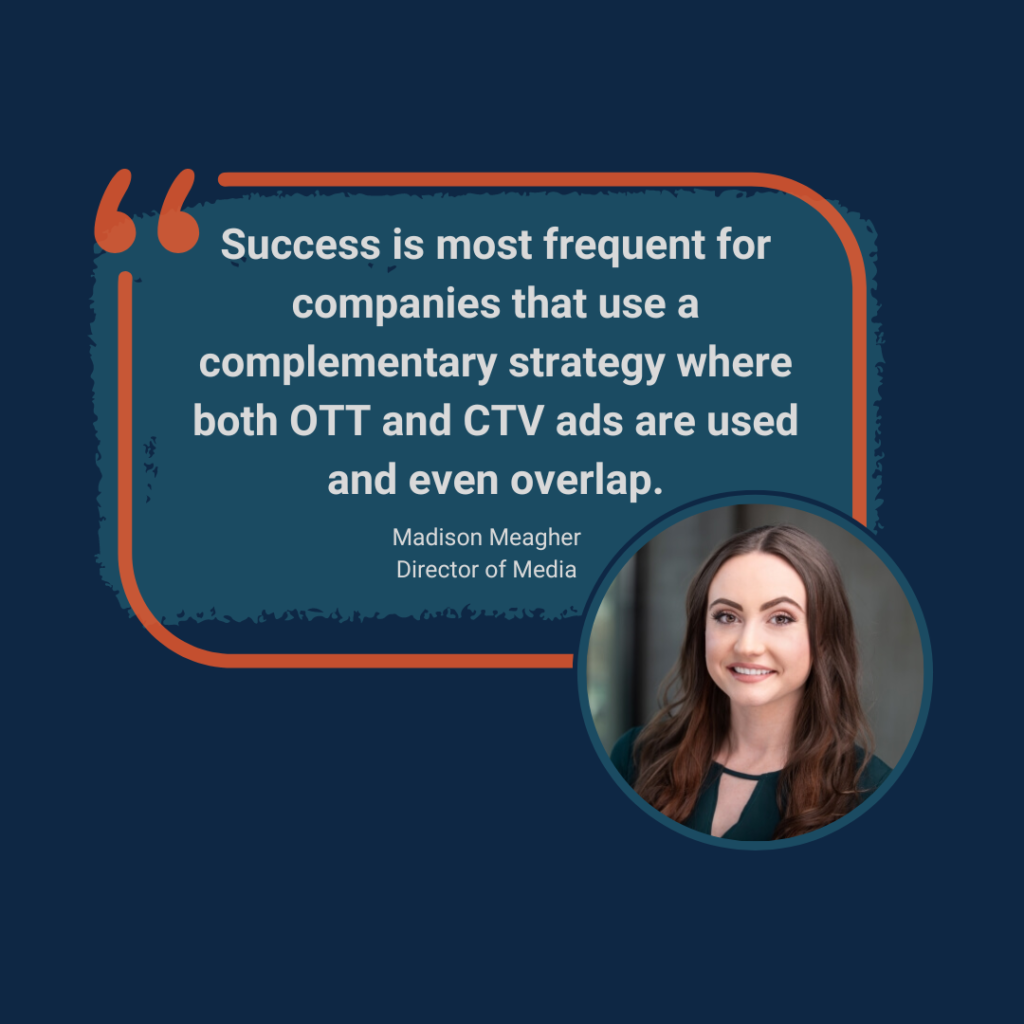OTT vs CTV Advertising: How Big of a Difference is There?
Since the 1940s, television commercials have been one of the most effective ways for companies to advertise their products and services. But the rise of high-speed internet has changed the way we consume video, as well as the types of ads we see.
Recent developments in video content include over-the-top (OTT) media services and connected television (CTV) devices, each of which has opened up new forms of advertising. We want to compare OTT and CTV advertising, looking at the differences and similarities and which one gets you the most bang for your buck.

OTT vs CTV
An “over-the-top” media service provides video content that can be viewed over the internet. Its etymology comes not from its flamboyant or extroverted nature, but from the concept of a video going “over the top” of traditional television formats like satellite and cable.
The most notable OTT services are subscription-based video-on-demand (SVoD) platforms like Netflix, Amazon Prime Video, and Disney+. However, OTT services also include scheduled, linear content streamed on the internet such as live sports broadcast platforms as seen on ESPN+.
Unlike traditional TV broadcasts, OTT media services can be accessed on a variety of devices, including computers, tablets, and smartphones. They can also be viewed on a connected TV, or “CTV.”
A CTV is a television set equipped with the ability to play media from the internet. One example of a CTV is a “smart TV,” which has a built-in operating system that connects to a local network allowing users to play online media via apps.
However, a TV without built-in smart functions can become a CTV with the use of a plug-in digital media player (such as Amazon Fire TV or Roku) or a network-connected games console (like a Playstation or Xbox).
How OTT and CTV Are Related
OTT and CTV are often spoken about in the same breath, and they are closely related. However, they are not the same thing.
The key thing to remember is that an OTT media service is a method of delivering video content, whereas a CTV is a physical device that can play such content. For example, you can watch OTT content — your favorite Netflix show, for example — on a CTV device like a Samsung Smart TV.
But there isn’t a complete overlap between OTT and CTV, since OTT content can also be accessed on other devices like computers and smartphones.
Advertising With OTT and CTV

You can purchase ad space across both OTT and CTV, or separately. OTT advertising targets video content (regardless of whether it’s viewed on a smartphone, computer, or CTV) while CTV advertising will only be seen on a television screen.
Both forms of advertising are great ways to connect with viewers — especially younger demographics. And it’s generally cheaper than linear TV advertising.
It helps to differentiate between the concepts of OTT and CTV, as some ads are better suited to the big screen while some work just fine on phones. That being said, advertising conversions happen on both, and success is most frequent for companies that use a complementary strategy where both OTT and CTV ads are used and even overlap. Because of this, many partners run a flat CPM to advertise on both CTV and OTT.
Price is the largest factor that may impact running ads on just CTVs instead of on both CTV and OTT. Hitting CTVs works great since the ad plays on a big screen and reaches users when they are already engaged. For example, it might reach a whole family sitting on the couch ready to watch a new movie instead of a singular user on their device, hence the premium rates. However, serving these same viewers similar ads across other devices is important for maintaining brand impact.
Finally, there are different types of inventory that may dictate what an advertiser runs. Video ads for OTT/CTV typically last between 15 and 30 seconds, with different rates and options depending on the placement. A pre-roll ad plays before the video content, while an in-stream or “mid-roll” ad plays during an interval.
Not all OTT/CTV ads are online video (OLV) ads though. For instance, some CTVs also sell home screen or screensaver ad space. See our guide to CTV ad specs for more information.
Pros and Cons of OTT Advertising

Pros of OTT Advertising |
Cons of OTT Advertising |
|
|
|
|
|
|
|
Pros and Cons of CTV Advertising

Pros of CTV Advertising |
Cons of CTV Advertising |
|
|
|
|
|
|
|
|
The Big Picture
OTT and CTV advertising can both be highly effective. But if a brand has to pick one or the other, OTT content is frequently favored over CTV because it allows for targeting across various devices. OTT is also more likely to drive immediate site visits since much of the inventory is clickable.
OTT may be favored for its versatility but, CTV ads can be incredibly powerful when clickthrough is not a priority, such as during awareness campaigns. But when it boils down to it, is there a winner for OTT vs CTV for your brand? Not necessarily. So, when it comes to choosing where to drop ad budget, make sure to consider what is most important to your campaign.

